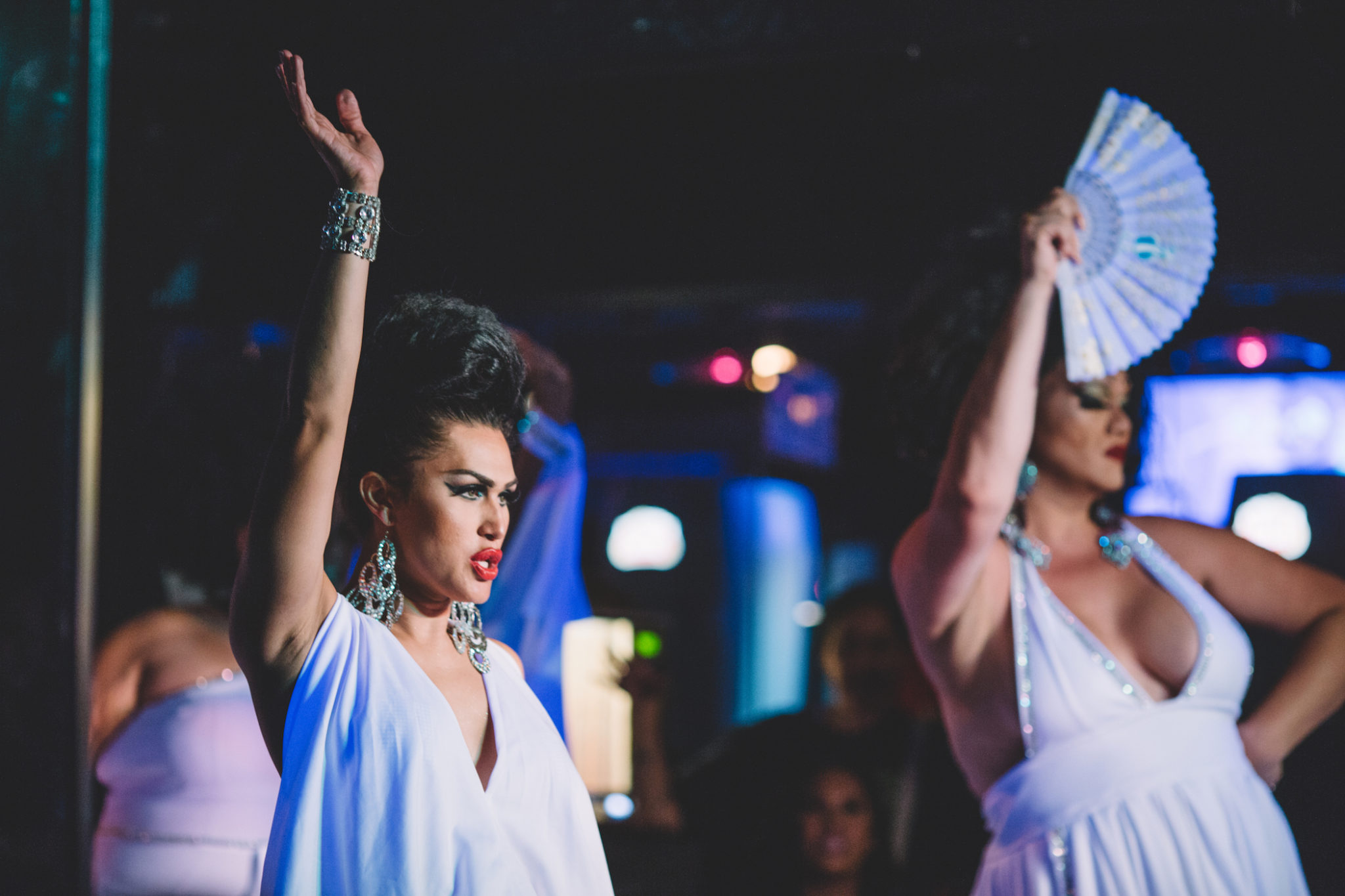A half-dozen clubs host drag queen shows throughout Honolulu on any given weekend. Here, a look into the showstopping culture.
Text by Sonny Ganaden
Images by Jonas Maon
Fusion Waikiki, or “Fusions,” as most locals call it, is a mainstay of the drag queen scene in Honolulu, serving liquor and hosting patrons until 4 a.m. since they opened in 1990. On Friday nights, starting at 10 p.m., Fusions is locally famous for its Gender Bender Lip Gloss Review, a showcase of both veteran and newcomer show queens.
The review can be considered traditional: Most performances are about the reveal, when a queen coyly emerges from the velvet curtains at the beginning of her song, dazzling in an outfit that matches the musical track to which she undresses and lip-syncs.
Under black lights and fueled by a two-drink minimum, the club takes revealing DIY outfits to the outer realms of relational aesthetics. Hosted by Leikia Williams, the review is a laugh riot, with frequent jokes about duct tape, genitalia, transgender identity, and debauchery.
Bucky Stun Guns
The night I visit is a send-off for crowd-favorite Bucky Stun Guns, who is taking a month hiatus to prepare for the upcoming Universal ShowQueen Pageant. Held annually in May, the pageant has become the Pacific’s premiere drag competition since its inception in 1984.
Spending her weekdays as a meter reader for the Honolulu Board of Water Supply, Stun Guns occasionally trades her blue collar for white rhinestones at Fusions. She has also performed with tours on the U.S. mainland and locally at luaus, weddings, and every other conceivable corner of Hawai‘i.
This night, during her second performance at Fusions, she saunters in a white gown and chandelier earrings to Madonna’s “Take A Bow” as a mix of visitors and locals gleefully dole out bills.
“The mainland has more festivity than our clubs,” she says after her performance, while accepting encouragement from patrons for the forthcoming pageant. “But we’re pretty competitive out here.”
The mainland has more festivity than our clubs. But we’re pretty competitive out here. – Bucky Stun Guns
You Will Also Like:
The Man and Queen Behind the Mustache
Hawai’i’s Rising Queens
In Honolulu, like in American media, drag has become mainstream. Any fan of RuPaul’s reality competition television series Drag Race could explain how the careers of Madonna, Channing Tatum, Lady Gaga, Tyler Perry, as well as shows like Lip Sync Battle and The Tonight Show with Jimmy Fallon, have lifted liberally from the styles and performances of drag culture, the kind of panoply that was expertly displayed in the documentary Paris is Burning, which followed the drag ball culture of New York City in the early to mid 1980s.
It was during that same era when philosopher Judith Butler coined the term “gender performance,” writing that gender is “an identity instituted through a stylized repetition of acts,” and that it “is instituted through the stylization of the body and, hence, must be understood as the mundane way in which bodily gestures, movements, and enactments of various kinds constitute the illusion of an abiding gendered self.”
The Glades
All this talk of socio-political analysis is boring once you hit the club. In Honolulu, drag culture has been a force in local entertainment and identity for at least half a century.
Most of the clubs have been, or historically have been located, in Waikiki and in Chinatown, situated in the heart of the Pacific city’s downtown. The Glades Project, a 2015 documentary by director and producer Connie M. Florez, excellently outlines the late 1960s to 1970s period.
The Glade Show Lounge, or The Glades, as it became known, was a late-night club and show place in Chinatown where outlandish drag performances were created, which were later adopted by emerging luau shows for tourists. During that era, as the dazzle of drag was appropriated for visitor entertainment, Honolulu drag clubs and performers were victims of the violence and intimidation familiar to that of the U.S. mainland.
Such tyranny included draconian laws that required performers to wear “I’m a boy” buttons, and stalking directed at performers and the trans community that frequented the scene. Despite this, the Glades was world-renowned for its scintillating, professional shows.
Growing Acceptance
The world has since become far more accepting. In Honolulu’s Chinatown, the club Scarlet has reinvigorated the neighborhood’s drag roots.
Two years ago, celebrity fashion designer and club owner Traver Rains met Hawai‘i television and radio host Lanai Tabura, who was on a mainland comedy tour.
“He said, ‘I know this spot that would make a great gay bar,’” Rains remembers of meeting Tabura. “And that was it. We saw the place and got to work.” The club was inspired by New York City parties, the artistry of Rains’ friend and collaborator David LaChapelle, and Rains’ fashion company, Heatherette, which takes its design cues from outlandish drag balls.
Incorporating those influences, Scarlet is an explosion of fun, with its constant rotation of new deejays, appearances by celebrity drag performers, and themed party nights. A side area next to the club’s dance floor has become the Pineapple Stage, where colors, sounds, and a sequined, surfing mannequin come roaring to life nightly, as if a Waikiki convenience store just exploded onstage.
Scarlet’s Saturday night show, Scarlet Fever, does not disappoint. Applying the level of rigor seen on RuPaul’s Drag Race, the show is more modern vaudeville than academic gender performance. And honey, do these queens perform.
Leave Them Wanting More
At promptly 10 p.m., the lip-syncing explosion begins with a newly choreographed ensemble routine and several group sequences that have performers sashaying around the club. Acting as emcee, Rains wears a trademark cowboy hat, sensible heels, loud pants, toned obliques, and a perfect smile.
“We’ve managed to bring nearly 200 performers here in the short time we’ve been open,” Rains says. “These girls usually stop in a town and are out, but here, they stay and get treated to the Hawai‘i experience. They leave obsessed and want to come back.”
Bucky Stun Guns will have ample competition at the Universal ShowQueen Pageant from Jerrica Benton, the current crown holder. Watching Benton’s solo numbers during Scarlet Fever, one would think her heels are made of military-grade steel and carbon, considering the stress they withstand as she twirls and pops perilously near the lip of the stage. Afterward, the expansive club practically throbs, packed with every version of partier in the Aloha State. Arguably, this Chinatown destination has become the best place to dance in the islands.
Since its opening, Scarlet’s ambiance has expanded local tastes.
“I’ve seen a change in plenty of the boys that have come here since we opened,” Rains says. “Now they’re showing up much more like themselves, in some heels and eye shadow, ready to dance.”
The charismatic entrepreneur is also opening a restaurant adjacent to Scarlet, and has plans to expand the club’s popular Thursday night amateur drag competition, Tropical Fish.
Long before drag blew up the spot in this diverse city, there were already entertainers and night shows. But the islands’ famous luaus and evening stage attractions owe significant credit to the garish, expertly created outfits and performances at The Glades.
And the fun of a modern night out in this Pacific metropolis owes a wink and a nod to Honolulu’s current drag renaissance.
Update:
Fusion Waikiki closed its doors in 2017. Scarlet is still hosting events, including Scarlet Fridays.






